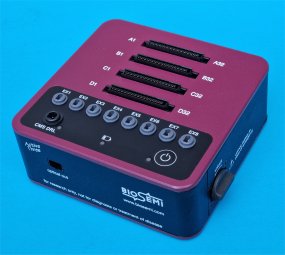 |
|
 |
|
 |
|
 |
|
 |
|
| ActiveThree AD-box "Unsurpassed EEG Signal Quality with Cutting-Edge SAR Technolog" | ||||||||||||||||||||||||||||||||||||||
ActiveThree is the next generation of biopotential measurement systems for scientific research. ActiveThree's signal quality surpasses any EEG system currently available thanks to cutting-edge SAR analog-to-digital converter technology. BioSemi's third-generation active electrodes and amplifier system - the ActiveThree - combines unsurpassed signal quality, portability, low power consumption, and ease of use. ActiveThree can come configured with up to 128+8 channels of EEG/EXG electrodes and sensors. All 142 channels are fully DC-coupled and equipped with a novel 24-bit SAR (successive approximation register) A/D converter. This is the latest ADC technology available on the market, allowing for the highest signal quality and a clean frequency spectrum. New low-voltage components further allow for low power consumption compared to its predecessors. As a result, a much smaller-sized battery is used, leading to a decrease in both the size and weight of the main AD-box. Additionally, the battery can be purchased anywhere locally, as it is a standard single battery cell. Auxiliary sensors such as respiration, temperature, GSR, plethysmograph and response switches are now automatically detected and configured by the system. Last but not least, the CMS/DRL circuitry has improved in interference suppression. |
||||||||||||||||||||||||||||||||||||||
|
128
channel AD-box with battery |
8
channel Amplifier/Converter module |
8
touchproofs for EOG,EMG, ECG. |
||
|
|
| Newly designed 'Auto-detect' Auxiliary inputs: The auxiliary sensor inputs on the ActiveThree have been completely re-designed with six highly versatile inputs. No matter the type of sensor, auxiliary sensors can selectively be connected to any of the six auxiliary inputs. ActiveThree auto-detects the connected sensor and transmits the correct configuration to ActiView acquisition software. ActiView automatically updates the display to show and record data from the connected sensors, without the need to manually configure the sensor. Available auxiliary sensors include: GSR/EDA electrodes Respiration belt Plethysmography (PPG) Temperature sensor (e.g., skin temperature) Response switch. |
|
| - GSR/EDA electrodes - Respiration belt - Plethysmography (PPG) - Temperature sensor (e.g., skin temperature) - Response switch |
|
Active Electrodes for Auditory Brainstem Response (ABR) |
Smaller Form-factor and Portability: |
Software adjustable Speedmodes: |


